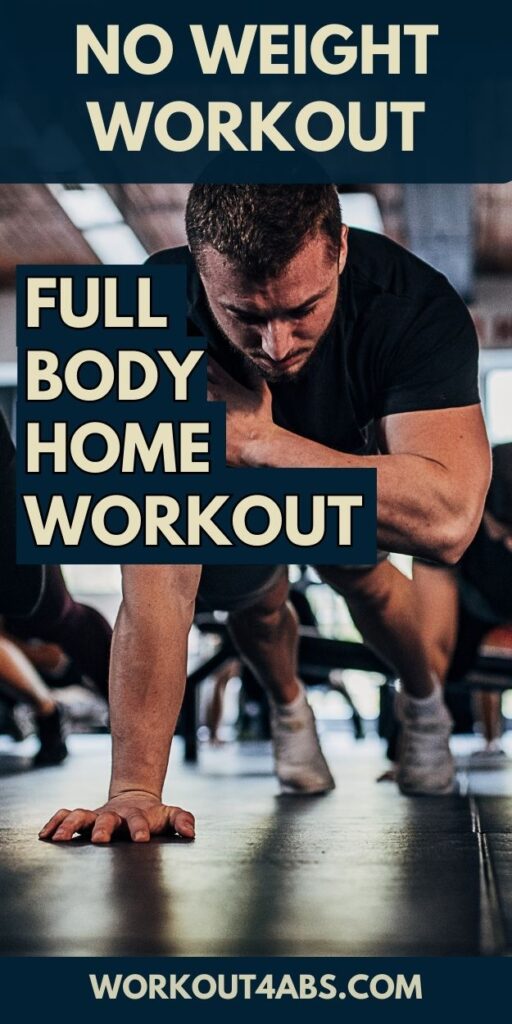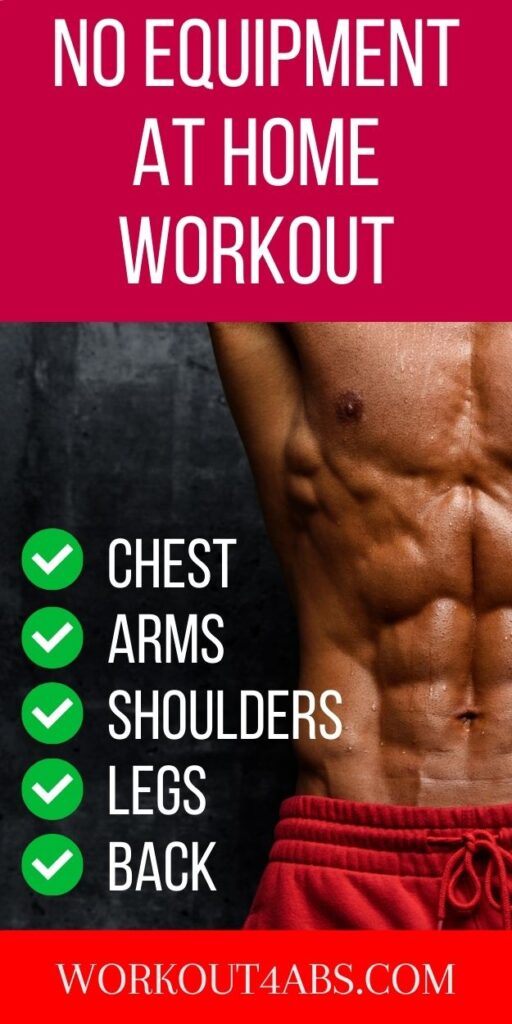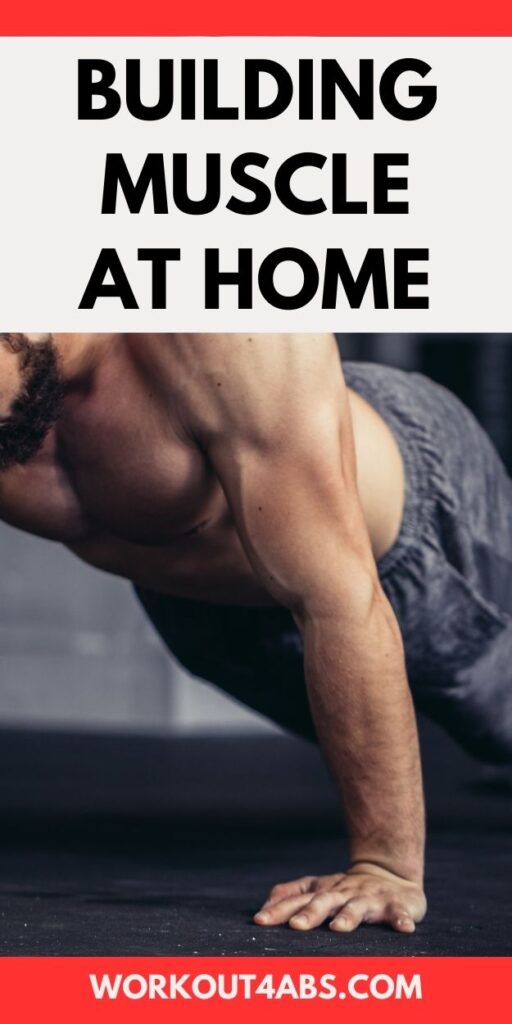Discover a workout plan without weights that will help you build muscle and lose weight. This is a dynamic workout plan that proves you don’t need weights to achieve impressive muscle gains and shed excess pounds. This comprehensive guide presents a holistic approach, blending bodyweight exercises, compound movements, and progressive strategies, all designed to elevate your fitness journey to new heights.
Building Muscle Without Weights (Muscle Building At Home!)
If you enjoyed these tips and you want to keep them close to you, please save this pin to your Pinterest Board.

Muscle Building Workout Plan
Here’s a sample month-long workout plan for building muscle without weights. This plan incorporates compound movements and follows a progressive overload strategy. Remember to warm up before each workout and cool down afterward. Feel free to adjust the intensity, repetitions, and rest periods based on your fitness level and goals.
Weeks 1 and 2: Establishing a Foundation
Day 1: Full Body
- Push-Ups – 3 sets of 10-12 reps
- Bodyweight Squats – 3 sets of 12-15 reps
- Inverted Rows (using a sturdy horizontal surface like a table) – 3 sets of 8-10 reps
- Plank – 3 sets of 20-30 seconds
Day 2: Lower Body
- Bulgarian Split Squats – 3 sets of 10-12 reps per leg
- Glute Bridges – 3 sets of 12-15 reps
- Calf Raises – 3 sets of 15-20 reps
- Plank – 3 sets of 20-30 seconds
Day 3: Upper Body
- Diamond Push-Ups – 3 sets of 8-10 reps
- Pike Push-Ups – 3 sets of 8-10 reps
- Chin-Ups (or assisted variations) – 3 sets of 6-8 reps
- Plank – 3 sets of 20-30 seconds
Day 4: Active Recovery
- Light jogging, cycling, or yoga for 30-40 minutes
Weeks 3 and 4: Increasing Intensity
Day 1: Full Body
- Decline Push-Ups – 3 sets of 8-10 reps
- Jump Squats – 3 sets of 10-12 reps
- Inverted Rows (with feet elevated) – 3 sets of 6-8 reps
- Plank with Shoulder Taps – 3 sets of 20-30 seconds
Day 2: Lower Body
- Plyometric Lunges – 3 sets of 10-12 reps per leg
- Single-Leg Glute Bridges – 3 sets of 10-12 reps per leg
- Calf Jumps – 3 sets of 15-20 reps
- Plank Variations (e.g., side plank) – 3 sets of 20-30 seconds
Day 3: Upper Body
- Wide Push-Ups – 3 sets of 8-10 reps
- Pike Handstand Push-Ups (or modified pike push-ups) – 3 sets of 6-8 reps
- Chin-Ups (increase repetitions or use less assistance) – 3 sets of 6-8 reps
- Plank with Leg Lifts – 3 sets of 20-30 seconds
Day 4: Active Recovery
- Low-impact activities, stretching, or mobility work for 30-40 minutes
Progressive Overload Strategy:
- Increase repetitions: Gradually increase the number of repetitions you perform in each set.
- Increase difficulty: Modify exercises to make them more challenging, such as adding pauses, increasing range of motion, or performing explosive variations.
- Decrease rest time: Gradually reduce the rest time between sets to increase the intensity.
- Incorporate advanced variations: As you progress, include more advanced variations of exercises.
Remember to listen to your body, prioritize proper form, and rest when needed. After this month-long plan, you can continue progressing by increasing intensity, varying exercises, and implementing more advanced techniques. It’s also beneficial to periodically reassess your goals and adjust your workout plan accordingly. If you’re new to exercise or have any health concerns, consider consulting a fitness professional before starting a new workout program.
How To Build Muscle At Home: The BEST Full Body Home Workout For Growth
Progressive Resistance Training Without Weights
Progressive resistance training is a method of gradually increasing the resistance or challenge of an exercise over time to promote muscle growth and strength development. While weights are commonly used for this purpose, you can still achieve progressive resistance training without weights by utilizing various techniques and creative approaches. Here’s how:
- Bodyweight Exercises: Bodyweight exercises use your own body as resistance. Examples include push-ups, squats, lunges, and planks. As you get stronger, you can increase the difficulty by changing the angle, leverage, or range of motion. For instance, you can progress from regular push-ups to incline push-ups and then to decline push-ups.
- Isometric Exercises: Isometric exercises involve holding a position without movement. Planks, wall sits, and static lunges are examples. Over time, you can increase the duration of these holds to challenge your muscles.
- Resistance Bands: Resistance bands provide external resistance without the need for weights. They come in different levels of resistance. As you become stronger, you can use bands with higher resistance. You can perform exercises like bicep curls, rows, and leg lifts using resistance bands.
- Elastic Tubing: Similar to resistance bands, elastic tubing provides resistance and can be used for exercises targeting various muscle groups. It’s versatile and portable.
- Plyometric Exercises: Plyometrics involve explosive movements like jumping, hopping, and bounding. These movements can increase muscular power and strength. Examples include squat jumps, burpees, and box jumps.
- Calisthenics: Calisthenics combines strength training and gymnastics, focusing on bodyweight exercises that improve strength, flexibility, and balance. Moves like pull-ups, dips, and muscle-ups provide a great challenge.
- Progressive Variations: You can modify exercises to increase difficulty gradually. For example, start with knee push-ups and progress to full push-ups, or begin with assisted pull-ups and work your way to unassisted ones.
- Tempo and Repetitions: Altering the tempo of your exercises (e.g., slowing down the lowering phase) and adjusting the number of repetitions can intensify the challenge.
- Unilateral Training: Work one side of your body at a time. This can help identify and correct muscle imbalances while adding resistance.
- Body Positioning: Changing your body positioning during exercises, such as elevating your feet during push-ups, can increase the challenge.
- Stability Exercises: Incorporate stability challenges by using an exercise ball, Bosu ball, or balance board. These exercises engage stabilizing muscles.
- Natural Resistance: Utilize your environment, such as using your body weight to perform exercises on stairs or using objects like furniture for support.
Remember to maintain proper form and technique to prevent injuries. Gradually increase the intensity, duration, or resistance of your exercises as you become stronger. Consistency is key for achieving progressive resistance and improvements in strength and muscle development. If you’re new to exercise or have any underlying health conditions, consider consulting a fitness professional or healthcare provider before starting a new training program.
If you enjoyed these tips and you want to keep them close to you, please save this pin to your Pinterest Board.

Compound Movement Exercises
Compound exercises are incredibly important when it comes to building muscle without weights. These exercises involve multiple muscle groups and joints working together in a coordinated manner. They provide numerous benefits that contribute to effective muscle development, even when you’re not using traditional weights. Here’s why compound exercises are crucial:
- Efficiency: Compound exercises target multiple muscle groups in a single movement. This efficiency means you can work on various muscles in less time compared to isolation exercises, which focus on a single muscle group.
- Hormonal Response: Compound exercises have been shown to elicit a greater hormonal response compared to isolation exercises. They stimulate the release of testosterone and growth hormone, both of which play a significant role in muscle growth.
- Muscle Activation: Compound movements recruit more muscle fibers across different areas, leading to more comprehensive muscle activation. This results in more balanced and functional strength gains.
- Functional Strength: Compound exercises mimic real-life movements and activities, making them highly effective for enhancing functional strength and improving your ability to perform daily tasks.
- Caloric Expenditure: Because compound exercises involve larger muscle groups, they require more energy and burn more calories, contributing to fat loss and muscle definition.
- Progressive Overload: Compound exercises can be easily adjusted for progressive resistance without weights. By altering angles, leverage, and movement patterns, you can continually challenge your muscles and promote growth.
- Time and Space Efficiency: Compound exercises are often bodyweight-based or require minimal equipment, making them suitable for home workouts or limited spaces.
- Muscle Balance and Coordination: Compound movements encourage better muscle balance and coordination between different muscle groups, reducing the risk of imbalances and injury.
Examples of compound exercises you can incorporate into your muscle-building routine without weights include:
- Push-Ups: Engage chest, shoulders, triceps, and core.
- Pull-Ups/Chin-Ups: Target back, biceps, and shoulders.
- Dips: Work triceps, chest, and shoulders.
- Squats: Engage quadriceps, hamstrings, glutes, and core.
- Lunges: Target quadriceps, hamstrings, glutes, and core.
- Planks: Engage core, shoulders, chest, and back.
- Burpees: Involve a full-body workout with cardiovascular benefits.
While compound exercises are essential, it’s also valuable to include some isolation exercises to target specific muscle groups that might not be as activated during compound movements. Balancing both compound and isolation exercises can lead to comprehensive muscle development and overall strength.
Remember to focus on proper form and technique to prevent injuries and maximize the effectiveness of your workouts. If you’re unsure about which exercises to include or how to structure your routine, consulting a fitness professional can provide personalized guidance based on your goals and fitness level.
If you enjoyed this workout plan without weights and would like to keep it close to you at any time, just save this pin to your Pinterest Board.

Home › Posture Exercises ›Workout Plan without Weights